Diffuse, distributed sources:
![]()
![]()
Part of my confusion about how to design a diffuser stems from my uncertainty about what types of real environments exist on the seafloor. My limited experience and a bit of imagination lead me to think that there may be a continuum of venting phenomena: from catastrophic phenomena more grand than any of the (few) "megaplumes" observed to date, all the way down through black smokers and tube worm beds, to warm conductively cooled basaltic crust. Through the submersible ports and cameras I have seen tube worm beds and lightly sedimented areas at the bases of scarps and atop horsts that emit shimmering evidence of buoyant fluid. While I have attempted to scale the diffuse sources in the lab based on such observations, it's worth asking whether we should categorize venting phenomena bimodally as "diffuse" and "focussed," or consider a broader range of possibilities?
Trivett (1994) characterizes diffuse hydrothermal sources as regions where "clear warm water emerges from cracks, fissures, or through porous sediments in the seafloor to make up a body of shimmering water rising" in microplumes with apparent initial velocities of much less than 10cm/s, and typical source temperatures of less than 20oC. He takes the diameter of an average diffuse patch as 50m, and chooses a source model 9cm in diameter (geometric scale ratio of 1:550). Subsequently, he proceeds to develop a model with which to assess what physical factors controlling the fate of diffuse flow in a unidirectional cross-current.
Using the 20cm-diameter coffee filter, I discovered that I could obtain a wide variety of flow behavior by altering either the exit velocity, initial density difference between the source and ambient fluid, and/or the density gradient (stratification, or stability(E)) in the tank. The fluid densities were controlled using various salt concentrations, and the details of the flow were observed using the "shadowgraph" technique, in which a distant point-source of white light is projected through the experimental tank and onto a viewing screen (posterboard or velum work well), revealing elegantly any density interfaces. I was amused to realize that the dynamics of plumes penetrating stratified fluid are independent of whether the source is placed at the top or bottom of a tank. (Indeed, I tried it both ways in most of the simulations I conducted, mostly in pursuit of improved visualization and tracer techniques.)
At miniscule flow rates and moderate density differences, I found that individual microplumes rose from each pore and flowed into either uniform or stratified fluid in a completely laminar fashion. Each plume consisted of a column with a diameter equal to the pore size (0.5mm), and was led vertically away from the filter by a mushroom-shaped head (3mm diameter) that eventually diffused into the tank fluid, becoming invisible on the shadowgraph.
As the flow rate (or pressure head) through the filter was increased, however, the individual plumes originating on the edge of the filter began to lean radially inward, indicating that the source was pulling ambient fluid towards its center. Furthermore, the central laminar plumes began to coalesce at about one source diameter into a unified column that rose like a turbulent plume, eventually equilibrating in the stratified tanks.
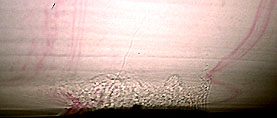 Thus, I began to see that the rate of flow (Q, m3/s) had a dramatic influence
on how the diffuse fluid behaved and was ultimately distributed in the tank.
I could achieve similar ranges of behavior by altering the density difference,
and was introduced to the combined concept of buoyancy flux
(B = (DeltaRho/Rho)*g*Q, m4/s3). The adjacent images portray the coffee
vent in action, with the tank stratified (0ppt NaCl on the top, 15ppt on the
bottom) and the source fluid fresh. At this juncture, I was not monitoring
Q quantitatively, and simply observed the fluid's fate. By dropping purple potassium
permanganate crystals on either side of the source, I could begin to glean how
ambient fluid was entrained.
Thus, I began to see that the rate of flow (Q, m3/s) had a dramatic influence
on how the diffuse fluid behaved and was ultimately distributed in the tank.
I could achieve similar ranges of behavior by altering the density difference,
and was introduced to the combined concept of buoyancy flux
(B = (DeltaRho/Rho)*g*Q, m4/s3). The adjacent images portray the coffee
vent in action, with the tank stratified (0ppt NaCl on the top, 15ppt on the
bottom) and the source fluid fresh. At this juncture, I was not monitoring
Q quantitatively, and simply observed the fluid's fate. By dropping purple potassium
permanganate crystals on either side of the source, I could begin to glean how
ambient fluid was entrained.
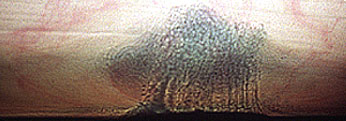 With no currents in the tank, the diffuse source seemed to be able to erode the
stratification, slowly increasing its rise height, and the height at which it
entrained fluid. The strongest entrainment seemed to be at the level of the
source itself, but the fluid was also drawn in powerfully at the level at which
turbulence developed fully. Counterintuitive entrainment often appeared above the
diffuse plumes (see the right hand potassium permanganate profile above),
suggesting that turbulent mixing at the plume top prefers to draw fluid in horizontally
along isopycnal surfaces. The outflow zones were clearly delineated,
especially in the stratified tanks, and the shape of the plume's base was
fascinating: often the inner plume was strongly turbulent, even as the
outer surface retained a sinuous texture, revealing that the flow was still
constituted by individual laminar microplumes.
With no currents in the tank, the diffuse source seemed to be able to erode the
stratification, slowly increasing its rise height, and the height at which it
entrained fluid. The strongest entrainment seemed to be at the level of the
source itself, but the fluid was also drawn in powerfully at the level at which
turbulence developed fully. Counterintuitive entrainment often appeared above the
diffuse plumes (see the right hand potassium permanganate profile above),
suggesting that turbulent mixing at the plume top prefers to draw fluid in horizontally
along isopycnal surfaces. The outflow zones were clearly delineated,
especially in the stratified tanks, and the shape of the plume's base was
fascinating: often the inner plume was strongly turbulent, even as the
outer surface retained a sinuous texture, revealing that the flow was still
constituted by individual laminar microplumes.
Classical plume theory rests on the entrainment assumption which relates the inflow (radial) velocity at the rising plume's boundary to the local (at that level) mean vertical velocity of turbulent flow by a constant (Turner 1986). If this assumption is true for a particular phenomena, a number of useful equations can be applied. For instance, the ultimate (equilibrium) rise height can be predicted if the buoyancy flux and frequency (N = ((g/RhoO)*dRho/dz)^1/2) are known. Additionally, if the assumption holds, then the entrainment profiles -- so easily observed with vertical tracers like potassium permanganate -- yield information about the vertical velocities in the plume.
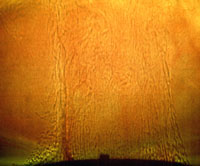 Is it reasonable to embrace the entrainment assumption for the
diffuse plumes I observed? Trivett(1994)
notes that the Reynolds number of the microplumes can be quite low,
but since the early models of plumes were formualted from low Reynolds number
tank experiments, the relevance is strong. Once the laminar microplumes
have coalesced, become turbulent, and begun to rise in a single column,
the flow appears similar to turbulent plumes from point sources, and thus the
entrainment hypothesis is likely true for them, too. The initial inward
shear, however, complicates the treatment of diffuse (broad diameter) sources as
turbulent plumes rising from a virtual source (Morton
et al. 1956).
Is it reasonable to embrace the entrainment assumption for the
diffuse plumes I observed? Trivett(1994)
notes that the Reynolds number of the microplumes can be quite low,
but since the early models of plumes were formualted from low Reynolds number
tank experiments, the relevance is strong. Once the laminar microplumes
have coalesced, become turbulent, and begun to rise in a single column,
the flow appears similar to turbulent plumes from point sources, and thus the
entrainment hypothesis is likely true for them, too. The initial inward
shear, however, complicates the treatment of diffuse (broad diameter) sources as
turbulent plumes rising from a virtual source (Morton
et al. 1956).
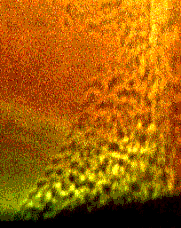 The intermediate scales of turbulence, then, there is potential intrigue.
When low density fluid enters a
higher density fluid body, a balance of momentum, buoyant forces, and viscous forces
ensues. In the diffuse flows I have witnessed, there seems to be extremely strong
entrainment in a very thin layer just above the source's surface.
Subsequently, the inflow becomes more moderate, and ultimately reverses in the outflow
zone. This is exactly what one would expect from the modelled velocity
profile of a turbulent plume (Speer and Rona 1989)
and the entrainment assumption.
The intermediate scales of turbulence, then, there is potential intrigue.
When low density fluid enters a
higher density fluid body, a balance of momentum, buoyant forces, and viscous forces
ensues. In the diffuse flows I have witnessed, there seems to be extremely strong
entrainment in a very thin layer just above the source's surface.
Subsequently, the inflow becomes more moderate, and ultimately reverses in the outflow
zone. This is exactly what one would expect from the modelled velocity
profile of a turbulent plume (Speer and Rona 1989)
and the entrainment assumption.
Subsequent experimentation with a diffuse line source (an aquarium aeration stone) suggests that other dynamics are possible, and that indeed, the geometry of the source may play a significant role in governing the nature of flow, and the turbulent structure of the flow governs the entrainment dynamics. The line source simulations were conducted in a thin tank (easier to stratify as it's volume is much smaller). (The consequent thermal influence of the tank's sidewalls is manifested in the ripple-like horizontal features that become visible as deflections vertical tracer profiles.) What causes the observed entrainment and multiple outflow zones portrayed in the following images? (The thin tank's fluid is stratified from 0ppt to 5ppt, the source fluid is fresh...)
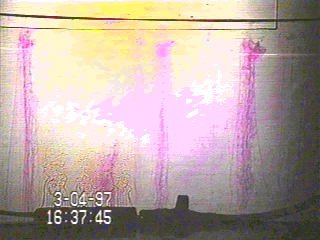


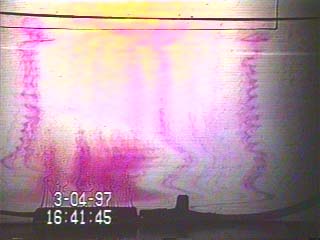
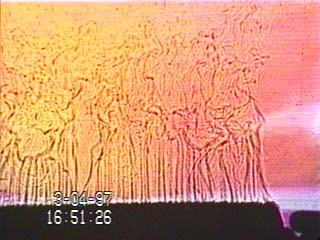 A (rough-looking) animated gif showcases the
evolution of the outflow layers over a few minutes of venting, and
emphasizes that something strange is going on with the entrainment
dynamics of this linear source. The close up of the exiting fluid below
illustrates that the onset of turbulence rarely reaches the airstone
surface, and is on average aligned with the (inflow?) zone centered
about 5cm above the source. Indeed, during the experiment,
downward motions were visible in depth
range of the first outflow zone (centered on 2cm) --
a consequence of longitudinal convection
(rolling parallel to the linear source), while the majority of the fluid
penetrated the stratification more deeply to equilibrate in the upper
neutrally-buoyant layer.
A (rough-looking) animated gif showcases the
evolution of the outflow layers over a few minutes of venting, and
emphasizes that something strange is going on with the entrainment
dynamics of this linear source. The close up of the exiting fluid below
illustrates that the onset of turbulence rarely reaches the airstone
surface, and is on average aligned with the (inflow?) zone centered
about 5cm above the source. Indeed, during the experiment,
downward motions were visible in depth
range of the first outflow zone (centered on 2cm) --
a consequence of longitudinal convection
(rolling parallel to the linear source), while the majority of the fluid
penetrated the stratification more deeply to equilibrate in the upper
neutrally-buoyant layer.
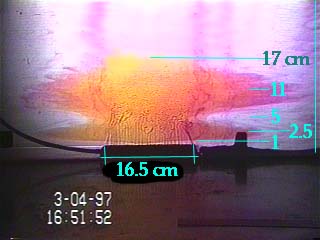 Because many of the
actively venting tube worm beds of the Endeavour
Segment have been mapped in rough association with linear faults and
fissures, it is exciting to expect that these more complicated
hydrographic features may result. After discussing a brief exploration of
focussed flow in an unstratified fluid volume, I will return to this
experimental setup and review the entrainment of this diffuse flow and
effluent by an intense, nearby, turbulent plume.
Because many of the
actively venting tube worm beds of the Endeavour
Segment have been mapped in rough association with linear faults and
fissures, it is exciting to expect that these more complicated
hydrographic features may result. After discussing a brief exploration of
focussed flow in an unstratified fluid volume, I will return to this
experimental setup and review the entrainment of this diffuse flow and
effluent by an intense, nearby, turbulent plume.
![]()
Previous Page | Table of Contents | Next Page
![]()
If you have comments or suggestions, email me at scottv@ocean.washington.edu
This research was conducted within the
University
of Washington Geophysical Fluid Dynamics Laboratory